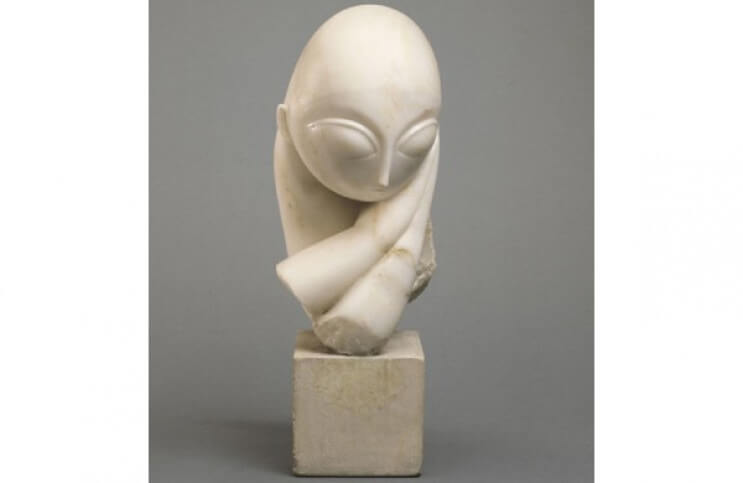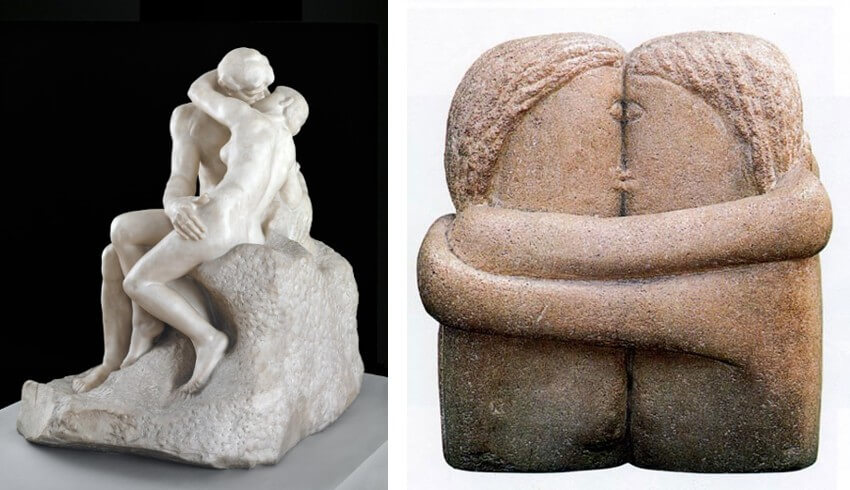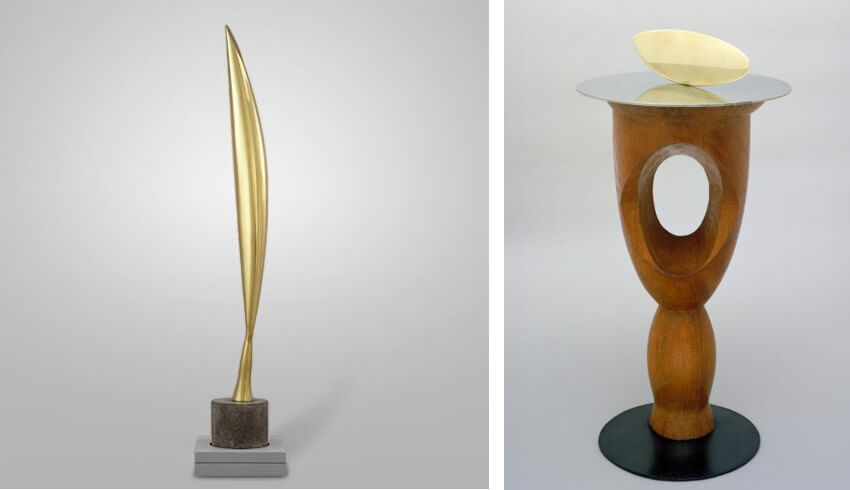
What We Learned from Constantin Brancusi ?
When you visualize an abstract sculptor, what comes to mind? Someone in rugged work clothes, covered in splotches of plaster? Someone serious, inquisitive, and obsessed with perfection? Someone visionary, brimming with both confidence and humility? That all may sound overly poetic, like a caricature. But it perfectly describes Constantin Brancusi, the father of Modernist abstract sculpture. The act of manifesting volume in space in a non-figurative isn’t easy. But when Brancusi first did it, it was almost unheard of. Brancusi pioneered the technical and aesthetic concerns that have shaped the way we understand abstract sculpture today. He was also integral to laying the field’s philosophical groundwork. To understand the trajectory abstract sculpture has taken over the past century, and the place it inhabits in the art world today, let’s go back and discover the source.
The Legend of Constantin Brancusi
Most photographs of a mature Constantin Brancusi show a sort of wild man with a deeply lined face, unkempt hair, a long beard and a wardrobe reminiscent of a vagabond. It might seem like a persona adopted to fit the public view of an artist, but in Brancusi’s case the look wasn’t an act. Few other famous artists have his salt-of-the-earth credentials. Constantin Brancusi was born to a peasant family in the Romanian countryside, about 50 miles from the modern Serbian border. Aside from the fact that he was herding sheep at age 7, the precise circumstances of his youth are unclear, but suffice to say that few happy children run away from home. Brancusi ran away multiple times, finally escaping for good around the age of only eleven.
He made his way 188 km to the city of Craiova. A relatively cosmopolitan place and home to around 40,000 people at the time, Craiova had an economy based on manufacturing and industry. Brancusi pieced together a living doing odd jobs, including reading fortunes and serving guests in a café. Eventually, he started taking classes in woodworking and found employment making furniture. Legend has it then that at the age of 18, he handmade a violin out of scrap wood. The violin impressed a wealthy patron who subsequently funded Brancusi’s education at the National School of Fine Arts in Romania’s capital, Bucharest. After graduating from the school with honors, Brancusi the former sheepherder, child runaway, street urchin and violin carver left home once again, according to some reports notoriously walking almost the entire 2300 km from Bucharest through Austria and Germany, all the way to Paris.
The Essence of Things
Upon arriving in Paris in 1904, Brancusi found himself in the center of a whirlwind of Modernist thought. He enthusiastically continued his studies in sculpture and within a couple of years found himself working as an assistant in the studio of one of the top sculptors of the age, Auguste Rodin. But after only a month working for Rodin, Brancusi left to focus on his own practice. One of the first sculptures Brancusi made on his own, in 1907, he named The Kiss, an apparent comment on Rodin’s famous sculpture of the same name made in 1889. Comparing the two works side by side demonstrates the vast difference between Brancusi’s vision and that of his brief mentor.
Aside from the obvious aesthetic divide, other profound differences separated the work of Brancusi and Rodin. Most importantly was the way each artist sought to express the true character of a subject. Rodin tended to over accentuate the muscularity of his subjects in order to communicate the power and spirit of their inner character. Brancusi took the search for the spirit of his subjects in a different direction, rejecting realistic form altogether in search of an abstracted form that could communicate what he called “the inner hidden reality.”
Another fundamental difference between the work of Rodin and Brancusi was in their method of creating. Rodin had pioneered a method of industrial scale production in order to create his monumental works in metal. He began a work by sculpting it in clay then employed a team of assistants to help him cast the final form out of metal or carve it out of marble. In direct opposition to that practice, Brancusi opted to make his sculptures by hand, carving them himself out of wood or stone, or casting them himself out of metal. The physicality of this method combined with the abstracted appearance of Brancusi’s sculptures helped establish the early Modernist focus on the importance of the artist’s hand and of the expression of a personal artistic vision.
 Rodin - The Kiss, circa 1882. Marble. 181.5 cm × 112.5 cm × 117 cm (71.5 in × 44.3 in × 46 in), © Musee Rodin (Left) and Brancusi - The Kiss, 1907, © Constantin Brancusi / Artists Rights Society (ARS), NY / ADAGP, Paris
Rodin - The Kiss, circa 1882. Marble. 181.5 cm × 112.5 cm × 117 cm (71.5 in × 44.3 in × 46 in), © Musee Rodin (Left) and Brancusi - The Kiss, 1907, © Constantin Brancusi / Artists Rights Society (ARS), NY / ADAGP, Paris
Surface and Shine
Along with his dedication to hand carving his sculptures, Brancusi also took immense care to tend to their surfaces, smoothing and shining them by hand until they were perfectly smooth and had a high level of sheen. His sculpture Portrait of Mademoiselle Pogany was ridiculed by critics because of its smooth, shiny exterior, which was likened to that of an egg. Princess X, one of Brancusi’s most controversial works of art, is a perfect example of his dedication to the surface qualities of his work. Made around 1915, this futuristic looking bronze sculpture caused an absolute stir at the Salon des Indépendants in Paris.
The controversy surrounding Princess X was that judges and viewers believed that it was intended to represent a phallus. Brancusi insisted that reading was incorrect. Rather, he insisted that the highly polished, mirrored sculpture was an abstracted version of the female form, suggestive of a woman’s head, neck and bust, her head tilting down to reflect upon herself in a mirror. Controversy aside, the piece helped define Brancusi’s iconic, highly polished aesthetic and his abstracted search for the “essence of things.”
 Constantin Brancusi - Princess X, 1915,Polished bronze; limestone block, 22 5/8 × 16 1/42 × 9 in, Philadelphia Museum of Art, © Art Resource, NY / Artists Rights Society (ARS), NY / ADAGP, Paris
Constantin Brancusi - Princess X, 1915,Polished bronze; limestone block, 22 5/8 × 16 1/42 × 9 in, Philadelphia Museum of Art, © Art Resource, NY / Artists Rights Society (ARS), NY / ADAGP, Paris
Animal Nature
Brancusi’s focus on abstract subject matter and formalist material qualities found heightened expression in several sculptures he made of animals in the 1920s. The most famous of his animal forms was called Bird in Space. A form he returned to over and over for many years, it was not intended to represent an actual bird, but was instead evocative of a bird’s wing, and intended to suggest the essence of flight.
Another of Brancusi’s animal sculptures, called Fish, almost appears at first to be figurative, as the top element appears to mimic the shape of a fish. But the form is pared down to a thin sliver. And the thin metal form is only one element of the entire piece. Brancusi made this sculpture so that the piece would serve as its own base. Rather than sitting upon a platform, Fish supports itself. Seen in context with its entire form, therefore, Fish becomes more symbolic. The fish-shaped metal element sits upon a mirrored plate, which rests upon a carved wooden form resembling a chalice. In the heart of the chalice is an opening reminiscent of an egg. Taken as a whole, the wafer thin form atop a plate atop a chalice evokes a communion service, an almost overt reference to Christian mythology.
 Constantin Brancusi - Bird in Space, Marble, 56 3/4 x 6 1/2 in (Left) and Fish, Bronze, metal and wood, 934 x 502 x 502 mm (Right), © Art Resource, NY / Artists Rights Society (ARS), NY / ADAGP, Paris
Constantin Brancusi - Bird in Space, Marble, 56 3/4 x 6 1/2 in (Left) and Fish, Bronze, metal and wood, 934 x 502 x 502 mm (Right), © Art Resource, NY / Artists Rights Society (ARS), NY / ADAGP, Paris
Base Elements
In addition to it’s pioneering Modernist embrace of mythological references, Brancusi’s Fish, and many other sculptures he made in the same vein, pioneered the concept that a sculpture and its method of support could be a united whole. The idea of a self-contained sculptural whole opened up a world of exhibition potential that allowed sculptural works to inhabit spaces in an entirely new way, not as an object on view within a space, but as an object that is participating in space, contextualizing and even defining it for viewers. Brancusi’s sculpture The Sorceress, created in 1920, is not only self-supporting, but the base seems to present an additional narrative element, evoking an altar supporting the apparent figure of a witch.
 Constantin Brancusi - The Sorceress, 1920,© Art Resource, NY / Artists Rights Society (ARS), NY / ADAGP, Paris
Constantin Brancusi - The Sorceress, 1920,© Art Resource, NY / Artists Rights Society (ARS), NY / ADAGP, Paris
Brancusi’s Contemporary Influence
By following his own ideas through to their conclusions, Brancusi created an aesthetic of surface and materiality that influenced movements as distant as Minimalism. His naturalistic carvings were some of the earliest examples of the biomorphic style embraced by artists such as Barbara Hepworth. His mixture of Modernism, myth and primitivism was a predecessor of neo-primitive movements like Lyrical Abstraction and Abstract Expressionism.
But aside from being an aesthetic pioneer in the realm of abstraction, Brancusi was a leader in mindset. He believed in his own ideas. Consider Brancusi’s most famous student, Isamu Noguchi. Prior to meeting Brancusi, Noguchi was ridiculed by his former teacher, the figurative sculptor Gutzon Borglum, famous as the creator of Mt. Rushmore. Borglum said Noguchi had no talent. Years later while traveling in Paris Noguchi took a position as Brancusi’s assistant. There, he received the encouragement that inspired his own journey as a Modernist master. This was Brancusi’s most important influence on the history of Modernist sculpture: His fierce dedication to the power and potential of an artist’s individual vision.
Featured image: Constantin Brancusi - Portrait of Mademoiselle Pogany, 1912, © Art Resource, NY / Artists Rights Society (ARS), NY / ADAGP, Paris
All images used for illustrative purposes only
By Phillip Barcio






